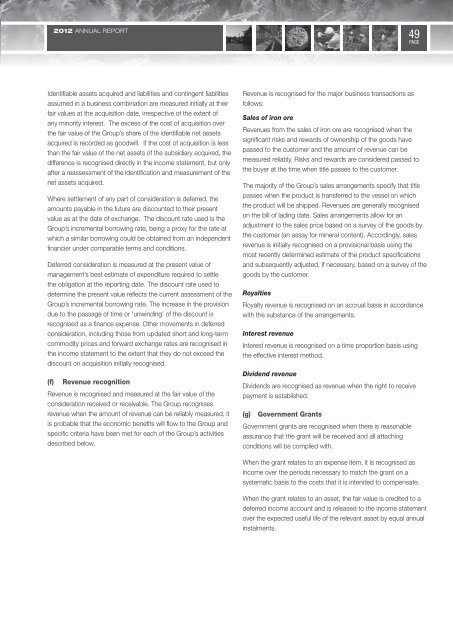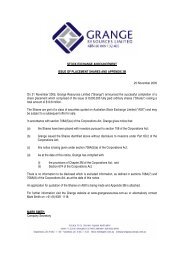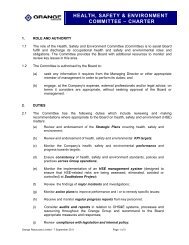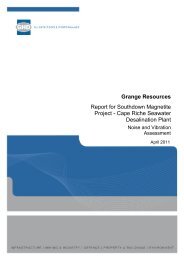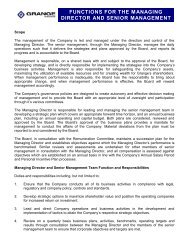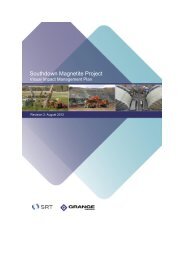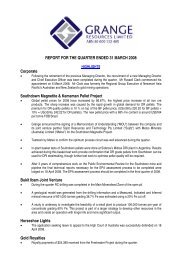2012 Annual Report (2 April 2013) - Grange Resources
2012 Annual Report (2 April 2013) - Grange Resources
2012 Annual Report (2 April 2013) - Grange Resources
You also want an ePaper? Increase the reach of your titles
YUMPU automatically turns print PDFs into web optimized ePapers that Google loves.
<strong>2012</strong> ANNUAL REPORT<br />
49<br />
PAGE<br />
Identifiable assets acquired and liabilities and contingent liabilities<br />
assumed in a business combination are measured initially at their<br />
fair values at the acquisition date, irrespective of the extent of<br />
any minority interest. The excess of the cost of acquisition over<br />
the fair value of the Group’s share of the identifiable net assets<br />
acquired is recorded as goodwill. If the cost of acquisition is less<br />
than the fair value of the net assets of the subsidiary acquired, the<br />
difference is recognised directly in the income statement, but only<br />
after a reassessment of the identification and measurement of the<br />
net assets acquired.<br />
Where settlement of any part of consideration is deferred, the<br />
amounts payable in the future are discounted to their present<br />
value as at the date of exchange. The discount rate used is the<br />
Group’s incremental borrowing rate, being a proxy for the rate at<br />
which a similar borrowing could be obtained from an independent<br />
financier under comparable terms and conditions.<br />
Deferred consideration is measured at the present value of<br />
management’s best estimate of expenditure required to settle<br />
the obligation at the reporting date. The discount rate used to<br />
determine the present value reflects the current assessment of the<br />
Group’s incremental borrowing rate. The increase in the provision<br />
due to the passage of time or ‘unwinding’ of the discount is<br />
recognised as a finance expense. Other movements in deferred<br />
consideration, including those from updated short and long-term<br />
commodity prices and forward exchange rates are recognised in<br />
the income statement to the extent that they do not exceed the<br />
discount on acquisition initially recognised.<br />
(f) Revenue recognition<br />
Revenue is recognised and measured at the fair value of the<br />
consideration received or receivable. The Group recognises<br />
revenue when the amount of revenue can be reliably measured, it<br />
is probable that the economic benefits will flow to the Group and<br />
specific criteria have been met for each of the Group’s activities<br />
described below.<br />
Revenue is recognised for the major business transactions as<br />
follows:<br />
Sales of iron ore<br />
Revenues from the sales of iron ore are recognised when the<br />
significant risks and rewards of ownership of the goods have<br />
passed to the customer and the amount of revenue can be<br />
measured reliably. Risks and rewards are considered passed to<br />
the buyer at the time when title passes to the customer.<br />
The majority of the Group’s sales arrangements specify that title<br />
passes when the product is transferred to the vessel on which<br />
the product will be shipped. Revenues are generally recognised<br />
on the bill of lading date. Sales arrangements allow for an<br />
adjustment to the sales price based on a survey of the goods by<br />
the customer (an assay for mineral content). Accordingly, sales<br />
revenue is initially recognised on a provisional basis using the<br />
most recently determined estimate of the product specifications<br />
and subsequently adjusted, if necessary, based on a survey of the<br />
goods by the customer.<br />
Royalties<br />
Royalty revenue is recognised on an accrual basis in accordance<br />
with the substance of the arrangements.<br />
Interest revenue<br />
Interest revenue is recognised on a time proportion basis using<br />
the effective interest method.<br />
Dividend revenue<br />
Dividends are recognised as revenue when the right to receive<br />
payment is established.<br />
(g) Government Grants<br />
Government grants are recognised when there is reasonable<br />
assurance that the grant will be received and all attaching<br />
conditions will be complied with.<br />
When the grant relates to an expense item, it is recognised as<br />
income over the periods necessary to match the grant on a<br />
systematic basis to the costs that it is intended to compensate.<br />
When the grant relates to an asset, the fair value is credited to a<br />
deferred income account and is released to the income statement<br />
over the expected useful life of the relevant asset by equal annual<br />
instalments.


